Junji Ito Adaptations: The Definitive Guide to Every Movie and Show Inspired by the Master of Horror
Discover every single movie and show, live-action and animated, that was inspired by the manga of Junji Ito. Also find out where (and if) you can watch them all, and where you can read the original manga they’re based on.
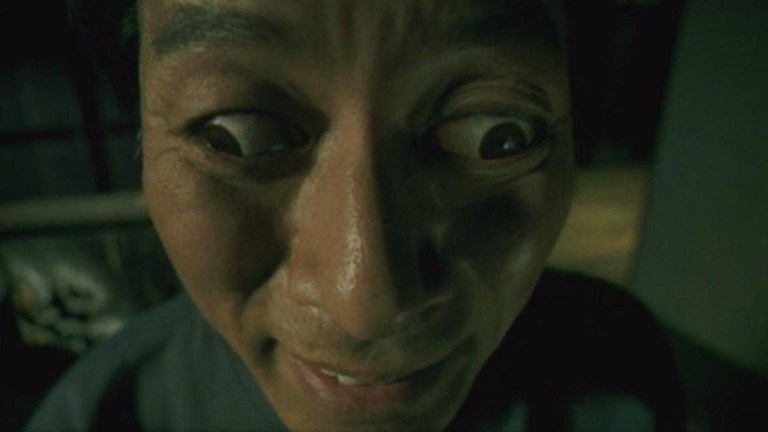
Table of Contents
Junji Ito’s name is synonymous with horror for legions of fans around the world. He is a manga artist who has been unsettling readers since his first story, “Tomie,” was published in 1987. Since then he has created a canon of horror stories that is beloved by people around the world.
Junji Ito’s stories range from cosmic horror, to body horror, to supernatural creepiness, to bloody messes. There’s also often a thread of humor running through his work. His writing style is engaging, and his art style is iconic. Since he is so talented and successful at crafting stories in the medium of manga, it makes sense that people would want to adapt his work into live-action and animation. Since 1991, there have been a good number of movies, TV shows, and streaming series based on Junji Ito’s manga. However, some of it is easier to access than rest.

This article compiles every movie and show that has been adapted from Junji Ito’s manga. For every title, the associated write-up gives a brief explanation of the story, a short history of when and where it was released (for most entries), and links to where you can watch it (when available) either on physical media or streaming. Also included in every write-up is the title of the original manga story that inspired the movie or show. The links in the titles of the manga direct you to the collection that the story is contained within.
Live-Action Movies
The Tomie Series (1998 – 2011)
Manga adapted from: Tomie

The Tomie series of movies is about obsession and death. It is centered on the title character, Tomie, who is a young woman who has a mysterious power that causes people to be overwhelmingly attracted to her. These attractions lead to jealousy, insanity, and many other negative emotions, often driving the people around Tomie to murder. Sometimes the victims are other admirers of Tomie, and sometimes the victim is Tomie herself. That’s okay though, because Tomie also has an inexplicable ability to regenerate her body and come back to life over and over again.
Most of the movies in the Tomie franchise aren’t directly connected to each other through continuing story lines (with the exception of Tomie: Beginning which is a prequel to 1998’s Tomie), so you can pick out any film to watch without worrying too much about being lost. Listed below are all of the movies currently in the Tomie series.
- Tomie (1998)
- Tomie: Another Face (1999) – Originally broadcast on TV as Tomie: Beautiful Girl of Fear (see the Television section below).
- Tomie: Replay (2000)
- Tomie: Re-Birth (2001)
- Tomie: Forbidden Fruit (2002)
- Tomie: Beginning (2005)
- Tomie: Revenge (2005)
- Tomie vs. Tomie (2007)
- Tomie Unlimited (2011)
Uzumaki (aka Spiral, 2000)
Manga adapted from: Uzumaki

Thanks to its striking visuals, Uzumaki may be the best live-action adaptation of any of Junji Ito’s manga. The film is about a small town in which the residents are slowly driven mad by spirals. The madness takes many different forms, resulting in a series of horrific and strange stories in which some sort of spiral is involved. Uzumaki was made before the manga it was adapting had finished, so the movie does feel like it ends too abruptly, especially if you’re familiar with the manga. Regardless, Uzumaki is still great for fans of odd horror movies that effectively blend campiness and creepiness.
Uzumaki was released in Japanese theaters on February 11, 2000, and it came out on DVD in Japan on January 21, 2001. It received its first DVD release in the United States in 2004 by Elite Entertainment, and much later, in 2022, it was released on Blu-ray by Discotek Media.
Junji Ito Horror Collection: The Hanging Balloon (2000)
Manga adapted from: “The Devil’s Logic,” “The Long Hair in the Attic,” and “Hanging Blimp“
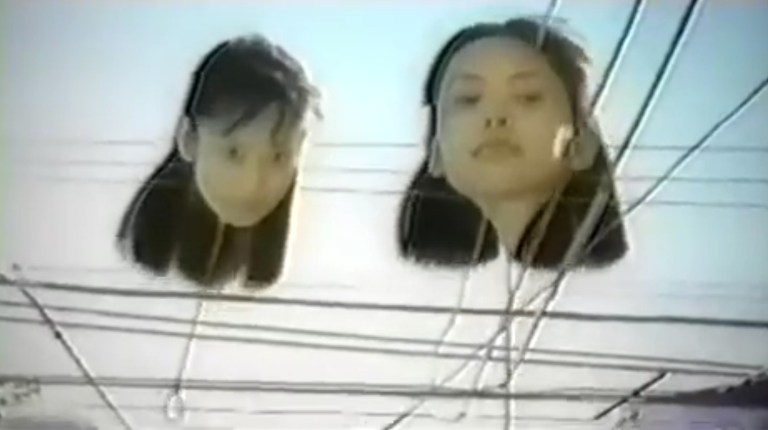
Junji Ito Horror Collection: The Hanging Balloon is an anthology movie made up of three short stories. First is “The Devil’s Logic,” directed by Takashi Shimizu (director of Ju-On: The Grudge as well as its American remake). “The Devil’s Logic” is a story about a high-school boy who secretly puts an audio recorder on his girlfriend’s school uniform, but what he hears drives him down a dark path. The second story is “Long Hair in the Attic” which tells the story of a young woman who becomes distraught after her boyfriend dumps her. “Hanging Balloons” is the last story, and it’s about giant, floating human-head balloons that kill people.
The history of Junji Ito Horror Collection: The Hanging Balloon is a little tough to piece together, but here’s what we could find from Japanese sources. Junji Ito Horror Collection: The Hanging Balloon was released on VHS by Daiei Video on May 12, 2000. It was never released on DVD, but you can find VHS tapes for sale in some places, and you can find poor-quality, unofficial streams of the film online.
Amazingly, multiple Japanese sources indicate that the three stories contained within Junji Ito Horror Collection: The Hanging Balloon were originally published online prior to being released on VHS. For example, the 2021 paper “Adaptations of Junji Ito Manga in J-Horror” by Noriaki Miyamoto of Kyoto University’s Department of Cinema and Media Studies lists these three shorts of the Junji Ito Horror Collection as a “web publication.” Also, the Japanese Horror Movies Database indicates that the three shorts were originally distributed through “internet TV.” The release dates given by the database are January 15, 2000 for “Long Hair in the Attic,” February 5, 2000 for “The Devil’s Logic,” and March 18, 2000 for “Hanging Balloons.”
Oshikiri: Movie Version (2000)
Manga adapted from: “Intruder” and “The Strange Tale of Oshikiri: The Walls“
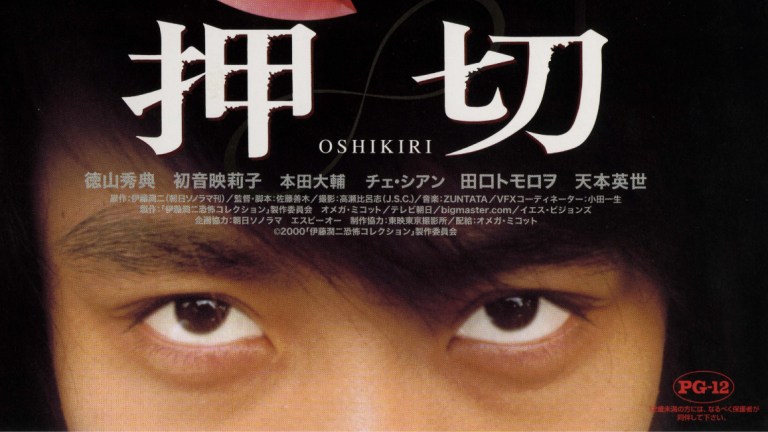
Oshikiri is a horror movie about a high-school student, Toru Oshikiri, who meets members of his school’s paranormal research group. After meeting with the group, Oshikiri goes to investigate a mansion where strange phenomena are said to occur. The mansion also happens to be where he lived with his grandfather as a small child, but he hasn’t been there for ten years. Soon, a killer carrying an axe and wearing a gas mask is seen, and people begin to suspect that the mysterious killer has a connection to Oshikiri.
Oshikiri was also a television miniseries which aired on TV Asahi in September of 2000 (see the Junji Ito Horror Collection in the Television section below). The TV and movie versions are made from the same footage, but Japanese sources indicate that the movie version is slightly altered.
Oshikiri: Movie Version was first released in a limited showing on August 12, 2000 at the Cinema Deux theater which used to be in the now-demolished Sony Tower in Osaka, Japan. It had another screening on September 2, 2000 at the Shinjuku Joy 3 theater in the Shinjuku ward of Tokyo. It was then released in on Japanese VHS and DVD on October 6, 2000. Oshikiri: Movie Version does not have an North American release.
Kakashi (aka Scarecrow, 2001)
Manga adapted from: “Kakashi“*

Kakashi is a good low-budget horror movie. Overall it feels like many other folk-horror-style Japanese horror movies where someone from the city travels to a remote village, finds out the locals have some truly odd quirks, and winds up in the middle of serious trouble. In Kakashi, Kaoru Yoshikawa travels to a small village in search of her missing brother Tsuyoshi. Kaoru is met with a cold reception from the villagers, and she has a supernatural mystery to unravel. Though it’s maybe more methodically paced than most other Junji Ito film adaptations, Kakashi is a good mystery-horror-thriller film even if it is significantly different from the original story in Ito’s manga.
Kakashi was released in Japanese theaters on June 15, 2001. Searching for Kakashi online, it doesn’t appear to have ever had an official home video release in North America. DVDs of Kakashi from other countries can be found, but if you’re looking to pick it up, make sure you check the region and language/subtitle options before you make a purchase. The movie is also currently streaming on the Japanese version of Amazon Prime Video.
Love Ghost (2001)
Manga adapted from: The first few chapters of Lovesickness, especially “The Beautiful Boy at the Crossroads.”

Love Ghost is about Midori, a high-school student who recently moved back to the town where she lived when she was little. Since she was a child, Midori has had a recurring nightmare about a man in black clothes walking towards her as she stands in front of a shrine. The shrine from her dream is real, and it is a place where the local teenagers go to perform a fortune-telling game called tsujiura. As described in the movie, tsujiura is when you stand in the street and ask the first random person who walks by if you will succeed in love. Unfortunately, the shrine where the teens do tsujiura is tied to a local legend, and everyone who asks their fortune feels the effects of the cursed location. As the people around Midori suffer, she begins investigating the shrine.
Of all of the movies adapted from Junji Ito’s stories, Love Ghost is probably the closest to what the general public recognizes about the J-horror cycle of the late nineties and early aughts. Meaning, it is a supernatural horror movie about a type of curse somewhat similar the curses in The Ring (1998) and Ju-On: The Grudge (2002). At the center of the movie is the mystery Midori is trying to solve, and around that are some nicely creepy moments and a few surprises. Love Ghost isn’t as good as some of the more popular J-horror movies of its era, but it’s absolutely worth checking out for fans of the genre. Love Ghost was released in the United States on DVD in May of 2006, and used copies aren’t too difficult to find at a reasonable price.
Marronnier (2003)
Manga adapted from: Possibly loosely inspired by “Marionette Mansion“

Marronnier (pronounced ma-row-knee-eh) is not a Junji Ito movie. Rather, it is a movie “presented by” Junji Ito. The story is an original work written by Hideyuki Kobayashi who also directed, shot, and edited the movie himself. The story is about a woman who is obsessed with a doll, but the dollmaker and his assistant are involved in some disturbing practices. It’s a complicated movie to explain because there is a lot going on, but basically it is a campy z-grade movie with living dolls, puppets made out of people, a strange machine that turns people into wax, stalking, murder, and dreams that might be reality. It’s weird.
Junji Ito is credited as a “supervising producer” of Marronnier, and he helped design the look of the dolls. The nearly-one-man crew of Hideyuki Kobayashi constructed the dolls. Junji Ito’s input other than some of the designs is unclear. The DVD of Marronnier, released in the USA in June of 2005, includes an interview with Ito where he talks about the movie a little, but he doesn’t really talk about his role in making it. Junji Ito does make a cameo in Marronnier as an artist who gives the main character a ride in his car. Other horror manga creators make on-screen appearances as well, including Senri Noguchi, Miyako Cojima (also spelled Miyako Kojima), Ochazukenori, and Misao Inagaki (who is actually the film’s co-lead, Mitsuba).
The Groaning Drain (2004)
Manga adapted from: “Umeku Haisuikan“*
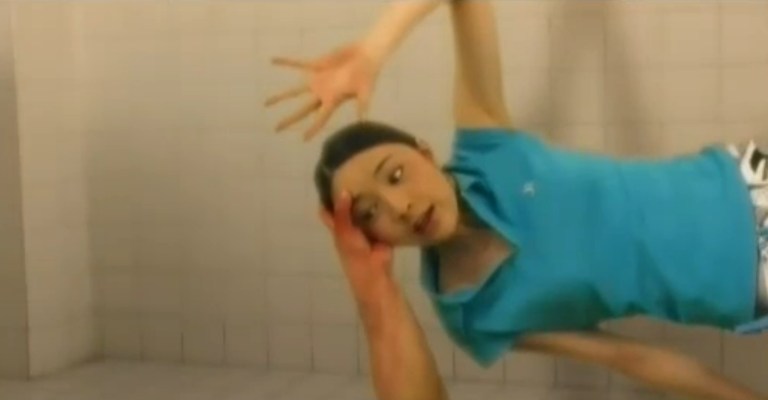
The Groaning Drain is the worst of the movie adaptations of Junji Ito’s manga, but it might also be the funniest in a “so bad it’s good” way. The story is about two sisters, Reina and Mari. Reina has a stalker, Mari has three male friends who are terrible people, and Reina and Mari’s mother is a germophobe. How all of this comes together as a story about a killer drain (or maybe better described as a killer in a drain) is incredibly strange.
The Groaning Drain doesn’t make much sense, and it isn’t scary. The original manga by Junji Ito is suitably disturbing, but it’s not something that would ever be easy to translate into live action. So instead of a direct adaptation of the manga, the movie takes some liberties with the plot, adds extra violence, and makes it all really silly. This one isn’t recommended for anyone except Junji Ito completionists and people who love awfully goofy horror movies.
Tomio (2011)
Manga adapted from: “Tomio • Red Turtleneck“
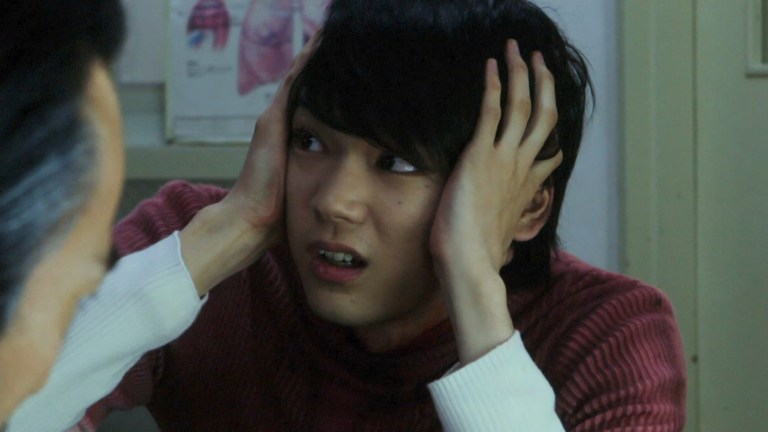
Tomio is a fun horror movie built on a simple premise—if Tomio takes his hands away from his head, then his head will fall off. Absurd? Sure, but lots of Junji Ito’s best stories start with an absurd central idea. The movie version of Tomio sticks very close to its manga source material. Tomio is in a good relationship with his girlfriend Madoka, and they plan to get married. But everything changes after they go to a fortune teller. The prediction is bad news, Tomio is seemingly entranced by the fortune teller, and when he attempts to come to his senses he puts his neck and head in serious jeopardy.
Tomio was part of a trio of movies collectively referred to as the Kojuncha project. The name “Kojuncha” comes from the names of the three manga artists involved in the project: Shinichi KOga, JUNji Ito, and oCHAzukenori. Each of the artists wrote and directed a movie, and the three films were screened over consecutive days in 2011 at the Eurospace theater in the Shibuya ward of Tokyo. Eko Eko Azarak: The First Episode of Misa Kuroi by Shinichi Koga screened August 27-29, Tomio by Junji Ito screened August 30-31, and Horror Mansion: The Blind by Ochazukenori screened September 1-2. Then, on September 2, 2011, all three movies were released on DVD.
Interestingly, even though Shinichi Koga and Ochazukenori’s movies were based on manga they had previously published, the Tomio manga had not yet been released. The manga of Tomio: Red Sweater was first published in Nemuki+ (Nemuki Plus) magazine in 2013, about two years after the movie came out. As for the movie, in 2014 it was released on DVD in the United States by Tokyo Shock, which is a sub-label of Media Blasters. It also received a streaming release on Amazon Prime Video. At only about sixty minutes long, Tomio is a good movie to watch when you want something quick, a little bloody, and quite amusing.
Television
The Fearsome Melody (1991)
Manga adapted from: “Used Record“

“The Fearsome Melody” is a 30-minute TV drama about a vinyl record that contains an entrancing song. It’s a pleasant melody, but it’s one that instills an overwhelming sense of possessiveness in whoever listens to it. Whoever listens to the record wants it, and they’ll do anything to get it. This quickly leads to trouble when a young woman steals the record from her friend and tries to find a place, in public, to play it. “The Fearsome Melody” was written and directed by Takumi Kimizuka, based on the manga “Used Record” by Junji Ito. The show sticks very close to the story of the manga, but the ending is altered in the television version.
“The Fearsome Melody” originally aired on television on October 16, 1991. It was broadcast on Kansai TV, a station that serves the Kansai region of Japan. The episode was part of an anthology series of 30-minute TV dramas collectively titled DRAMADOS, which aired late at night on Kansai TV every Wednesday from April 3, 1991 to March 18, 1992.
Eventually, “The Fearsome Melody” was released on DVD in Japan on July 29, 2005. The title of the DVD translates to DRAMADAS Junji Ito + Tatsuhiko Yamagami: Fearsome Melody/White Fingers on the Grater. The reason the DVD has the title DRAMADAS and not DRAMADOS is because the other TV drama included, “White Fingers on the Grater,” aired as part of DRAMADAS, which was was an anthology series that aired five 15-minute episodes a week. DRAMADAS preceded DRAMADOS, airing on late-night Kansai TV from April 9, 1990 until March 29, 1991. Unfortunately, “The Fearsome Melody” doesn’t have a release in North America.
Tomie: Beautiful Girl of Fear (1999)
Manga adapted from: Tomie
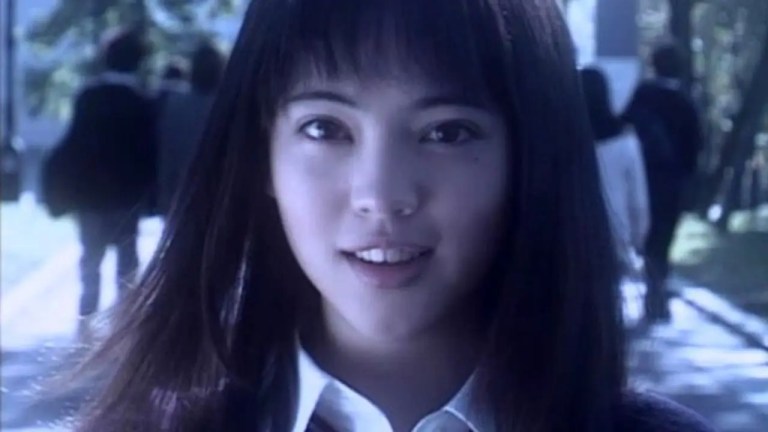
Tomie: Beautiful Girl of Fear (a rough translation from the original Japanese title) is a made-for-TV anthology film consisting of three short stories. Though each story has a different setting, Tomie is played in all three segments by actress Runa Nagai. The first story involves a resurrected Tomie stirring up trouble in high school. The second story is about a photographer who encounters someone who looks just like his lost love… who also happens to be Tomie. The final story involves Tomie trying to convince her new love to defend her life by killing the man who has been tracking her throughout the previous two stories.
Tomie: Beautiful Girl of Fear was broadcast on Kansai TV on December 26, 1999. It was released in Japan on VHS and DVD with the title Tomie: Another Face in 2000, and it was later released on DVD in the United States in 2004. Tomie: Beautiful Girl of Fear was directed by Toshiro Inomata, and the script was written by Shotaro Oikawa based on Junji Ito’s manga.
Junji Ito Horror Collection (2000)
Manga adapted from: listed in the write-up below

Though it contains a similar title to various other collections, this Junji Ito Horror Collection (also called The Horror World of Junji Ito) is a series of TV dramas that aired on TV Asahi in Japan. The series consists of adaptations of four of Junji Ito’s stories which aired over multiple weeks from July to September of 2000. “Long Dream” is a creepy story about a man whose dreams last for days, then years, then much, much longer. “Face Thief” is about a girl who can perfectly mimic the appearance of anyone. “Oshikiri” tells the story of a high-school student named Oshikiri who investigates mysterious inter-dimensional happenings. And “Gravetown” is about a small town that contains an abnormally large number of grave markers located in the strangest places.
The first of the three stories in the Junji Ito Horror Collection were broadcast on Asahi TV as miniseries broken up into 30-minute segments, airing late at night on Fridays in the year 2000. “Long Dream” aired July 7 and 14, “Face Thief” aired August 4, 11, and 18, and “Oshikiri” aired September 1, 8, 15, and 29. “Gravetown” was a special episode that is about 60 minutes long, and it aired on Saturday, September 30, 2000. Listed below are the four stories along with the manga they are based on and home-video release information (if any). None of the episodes are currently streaming via official sources.
- “Long Dream” is adapted from “The Long Dream,” and it received a Japanese VHS and DVD release in late 2000, and it was released in 2008 on DVD in the United States.
- “Face Thief” is adapted from “Face Thief,” and it was released on VHS and DVD in Japan in late 2000.
- “Oshikiri” is adapted from “Intruder” and “The Strange Tale of Oshikiri: The Walls,” and it was released on Japanese VHS and DVD in October of 2000 as Oshikiri: Movie Version (see the Movie section above for more information).
- “Gravetown” is adapted from “Tombs,” and it doesn’t appear to have a home video release.
The Earthbound (2015)
Manga adapted from: “Earthbound“
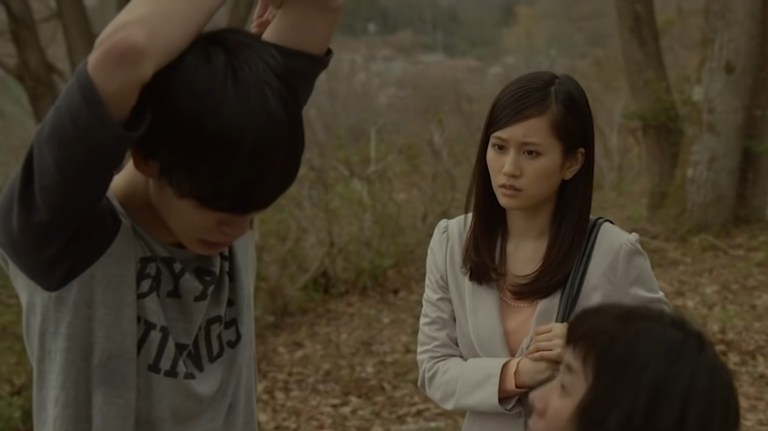
In “The Earthbound,” a strange phenomenon begins in which some people, in seemingly random locations, become frozen in place. The people are stuck in odd poses and can move their bodies only very slightly while standing in place. They can’t walk away, and no one can move them since it’s like they are now a part of the ground they stand on. A social worker attempting to help the afflicted people soon starts to understand the reason why these people are earthbound after she has a close, personal encounter with one of them.
“The Earthbound” aired on television on April 11, 2015 as part of a special episode of the long-running series The Strangest Story in the World. It was aired as part of the Spring special televised during the 25th anniversary of the series. The episode is 130 minutes long, and it is made up of five short films based on stories from popular manga artists. In addition to Junji Ito, the shorts adapted manga from Go Nagai, Eiichiro Oda, Kazuo Umezu, and Masayuki Ishikawa. Unfortunately, it doesn’t look like there is any streaming or physical release of “The Earthbound.” But, from summaries of the episode found online, it’s clear that the live-action version is altered from the manga and has a different ending.
Anime
Gyo: Tokyo Fish Attack (2012)
Manga adapted from: Gyo
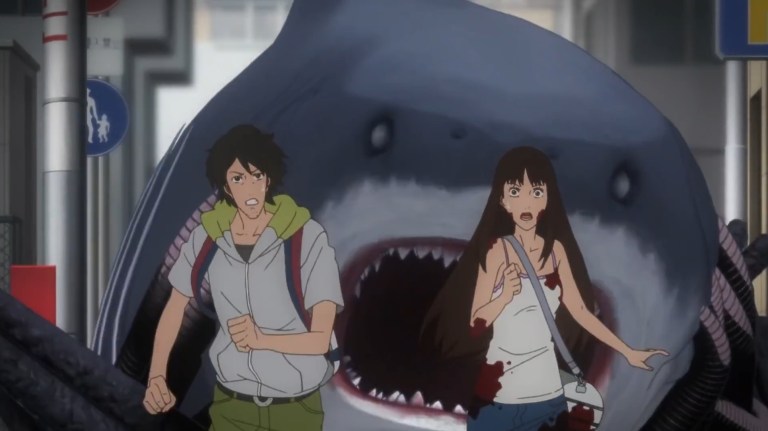
Gyo: Tokyo Fish Attack is a 70-minute anime movie (technically it’s an OVA, original video animation). The story follows Kaori as she takes a trip to Okinawa to celebrate her upcoming graduation. A shark with spider-like legs forces its way into Kaori’s cabin and attacks, but that’s just the beginning. Kaori is soon headed back to Tokyo to find her fiancé, but skittering sea creatures with a taste for killing are already flooding into the city’s streets. Gyo: Tokyo Fish Attack feels a lot like a sci-fi monster/disaster movie at first, but by the end it adds in a lot more body horror and creepiness. It’s a decent attempt at adapting the original story into anime, though it does make changes to Junji Ito’s original work.
Gyo: Tokyo Fish Attack was part of the “Anime Bunko” collaboration between entertainment company Aniplex and animation studio Ufotable. The other projects released by Anime Bunko were Yuri Seijin Naoko-san and Minori Scramble. Gyo had a limited premiere screening in 2011 at Theatre Shinjuku in the Shinjuku ward of Tokyo from October 29 to November 4 where it played along with another Ufotable animation, Sakura no Ondo (which is not part of Anime Bunko). Yuri Seijin Naoko-san and Minori Scramble also screened at the same theater, from November 5 to 11.
Gyo and the other two Anime Bunko titles were released, separately, on DVD and Blu-ray in Japan on February 15, 2012. Aniplex of America released Gyo: Tokyo Fish Attack on DVD in America on July 9th, 2013. Unfortunately the DVD is hard to find now, and prices on auction sites can be ridiculous. There is a DVD release from the UK which is much more affordable, but you need a way to play region 2 discs if you buy it. Also, there is no officially licensed streaming version of Gyo as of this writing.
Junji Ito Collection (2018)
Manga adapted from: listed in the write-up below
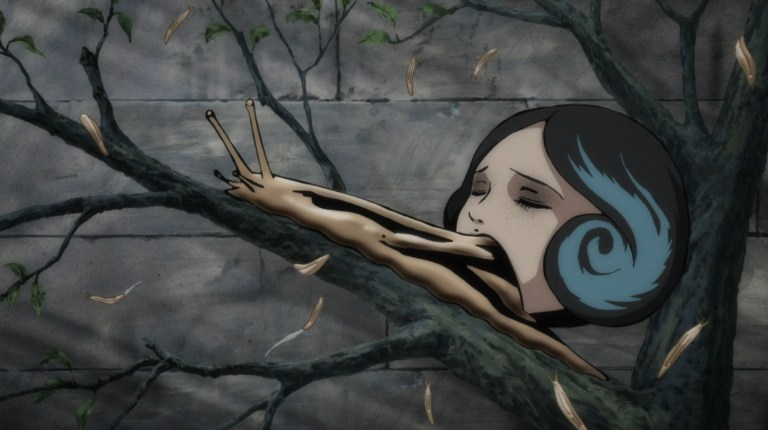
Junji Ito Collection might not have the most original title, but it is notable as the first time Ito’s manga was adapted in an animated anthology series format. The series ran for twelve episodes with each episode containing two stories. There are also two additional OVA episodes that focus on the character Tomie. With animation from Studio Deen, Junji Ito Collection is an entertaining horror series, but attempting to adapt Junji Ito’s extremely moody and detailed artwork into a more simplistic style loses something in the translation.
Junji Ito Collection aired on Japanese television and streamed online between early January and late March of 2018. The series was released in Japan on three DVDs which were released in March, April, and May of 2018. For viewers in the United States and other areas, Junji Ito Collection is streaming on Crunchyroll. Below are all of the episodes in the series, along with the story titles for each episode and where you can find the collections containing the original manga each story is based on. Links marked with a * mean that no official English translation is currently available.
- Episode 1
- “Souichi’s Convenient Curse” adapted from “Soichi’s Petty Curses“
- “Hell Doll Funeral” adapted from “The Hell of the Doll Funeral“
- Episode 2
- “Fashion Model” adapted from “Fashion Model“
- “The Long Dream” adapted from “The Long Dream“
- Episode 3
- “Boy at the Crossroads” adapted from “The Beautiful Boy at the Crossroads“
- “Slug Girl” adapted from “Slug Girl“
- Episode 4
- “Shiver” adapted from “Shiver“
- “Marionette Mansion” adapted from “Marionette Mansion“
- Episode 5
- “The Ongoing Tale of the Oshikiri Collection” adapted from “The Strange Tale of Oshikiri“
- “Cloth Teacher” adapted from “Teacher of Cloth“
- Episode 6
- “Window Next Door” adapted from “Window Next Door“
- “Gentle Goodbye” adapted from “Gentle Goodbye“
- Episode 7
- “Used Record” adapted from “Used Record“
- “Town of No Roads” adapted from “Michi No Nai Machi“*
- Episode 8
- “Honored Ancestors” adapted from “Honored Ancestors“
- “The Circus Comes to Town” adapted from “Sakasu ga Kita“*
- Episode 9
- Episode 10
- Episode 11
- “Supernatural Transfer Student” adapted from “Chousizen Tenkousei“*
- “Scarecrow” adapted from “Kakashi“*
- Episode 12
- OVA 1 – “Tomie Part 1” adapted from “Tomie“
- OVA 2 – “Tomie Part 2” adapted from “Tomie Part 2: Morita Hospital“
Junji Ito Maniac: Japanese Tales of the Macabre (2023)
Manga adapted from: listed in the write-up below
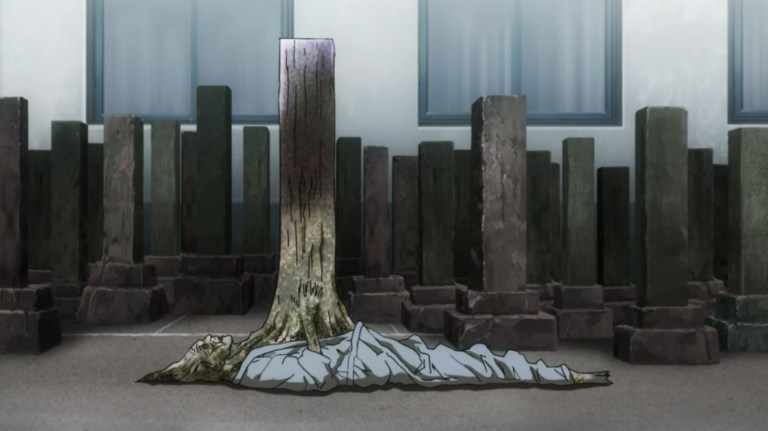
Junji Ito Maniac: Japanese Tales of the Macabre is very similar to the 2018 anime series Junji Ito Collection. In fact, it’s animated by the same studio, Studio Deen, with many of the same people working on both shows, so it is essentially (and unofficially) season two of Junji Ito Collection. Junji Ito Maniac is a twelve episode anthology series that adapts various stories originally created by Junji Ito. The majority of the episodes contain two stories, and overall the series is pretty good. This series, like the previous one, fails to truly capture the unnerving nature of the original manga, but it’s the best animated version of Junji Ito’s work made so far. It was distributed exclusively on Netflix in January of 2023.
Listed below are all of the episodes of Junji Ito Maniac, along with the story titles for each episode and links to the collections where you can read the original manga. Links marked with a * mean that no official English translation is currently available.
- Episode 1
- “The Strange Hikizuri Siblings” adapted from “The Séance“
- Episode 2
- “The Story of the Mysterious Tunnel” adapted from “The Strange Tale of the Tunnel“
- “Ice Cream Bus” adapted from “Ice Cream Bus“*
- Episode 3
- “Hanging Balloon” adapted from “Hanging Blimp“
- Episode 4
- “Four x Four Walls” adapted from “Four-Layered Room“
- “The Sandman’s Lair” adapted from “Where the Sandman Lives“
- Episode 5
- “Intruder” adapted from “Intruder“
- “Long Hair in the Attic” adapted from “Long Hair in the Attic“
- Episode 6
- “Mold” adapted from “Kabi“*
- “Library Vision” adapted from “Library Vision“
- Episode 7
- “Tomb Town” adapted from “Tombs“
- Episode 8
- “Layers of Terror” adapted from “Kyoufu no Jyusou“*
- “The Thing that Drifted Ashore” adapted from “Washed Ashore“
- Episode 9
- “Tomie: Photo” adapted from “Tomie: Photo“
- Episode 10
- “Unendurable Labyrinth” adapted from “Unendurable Labyrinth“
- “The Bully” adapted from “Bullied“
- Episode 11
- “Alley” adapted from “Rojiura“*
- “Headless Statue” adapted from “Kubi no Nai Choukoku“*
- Episode 12
- “Whispering Woman” adapted from “Whispering Woman“
- “Soichi’s Beloved Pet” adapted from “Soichi’s Beloved Pet“
Planned and Upcoming Junji Ito Adaptations
Bloody Smart (date TBD)
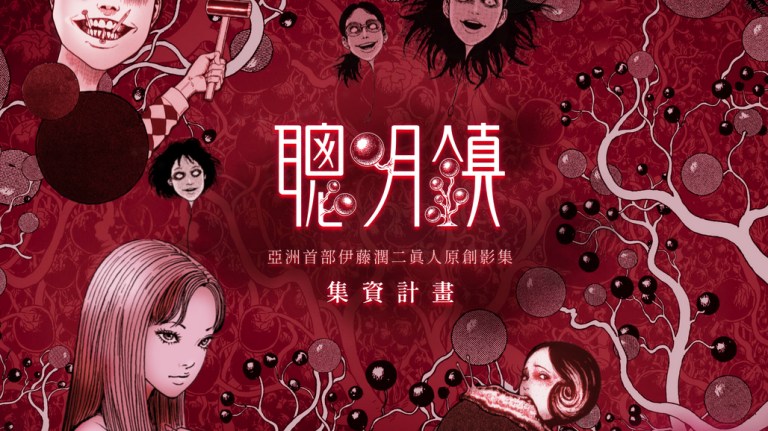
Bloody Smart (translated from Chinese as Smart Town) is a planned live-action Taiwanese TV series that began production in 2022. It is a Chinese-language episodic series starring actress Gigi Leung as a single mother who enrolls her daughter in a new school, but strange events begin occurring. By the looks of the official Bloody Smart web site and some of the concept art, Junji Ito characters and stories including Tomie, Tomio, Souichi, “Slug Girl,” “Hanging Balloons,” and “The Beautiful Boy at the Crossroads” will all be adapted in some way throughout the series. A fundraising campaign was started in 2022 to help with post-production, but since then information about the project has been difficult to come by. Hopefully it will be completed and released internationally.
Uzumaki Anime (date TBD)
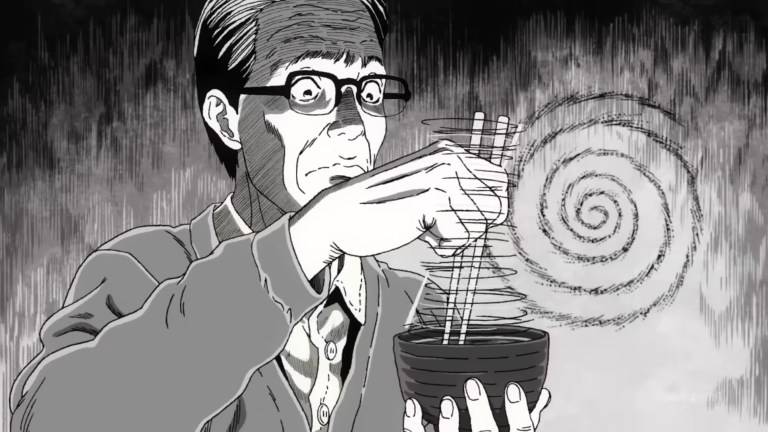
One of Junji Ito’s most popular stories, Uzumaki, is set to become an anime miniseries, but when and where it will be released is a mystery. Uzumaki is planned as a four-episode series, but it has been subjected to lengthy delays. The project wast first announced back in 2019, but news about it has been limited ever since. In June of 2022, the official Uzumaki twitter account tweeted an announcement that the series would be delayed due to the production team needing more time to faithfully adapt Junji Ito’s detailed art style. Then in 2023, Jason DeMarco of Adult Swim and Toonami tweeted that Uzumaki would come out sometime in 2023. That didn’t happen. So now we just have to wait for what might be the best Junji Ito animated adaptation yet.
Bloodsucking Darkness (date TBD)

On March 30, 2023, Fangoria announced that Fangoria Studios would be producing three live-action movies based on Junji Ito’s work. The first and only title named was Bloodsucking Darkness which is based on the story of the same name from the manga collection Smashed. Since the announcement, no new developments have been revealed to the public.
Frequently Asked Questions
Is all of Junji Ito’ manga available in English?
How can I watch Junji Ito’s movies and shows only released in Japan?
If the movie or show was released only in Japan, then the link will direct you to the Japanese version of Amazon. Amazon Japan will sometimes ship to other countries depending on the item and seller, but if they don’t ship outside of Japan you’ll need to use a proxy shipper. A proxy shipper will buy the product for you and ship it to you. Japan Rabbit is a proxy shipper that is simple to use and has great service (note: this is not a paid advertisement, I’m just sharing my honest opinion on the service they provide based on using them multiple times).
Unfortunately, if the link in the title of the movie or show you want doesn’t go to either USA or Japan Amazon, or to a streaming service, then it probably doesn’t have an official release available anywhere.
